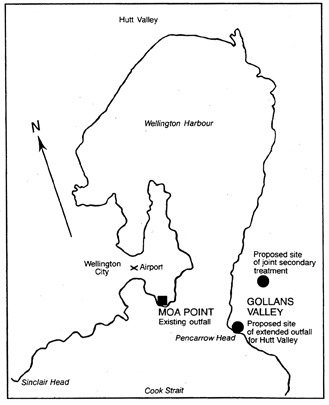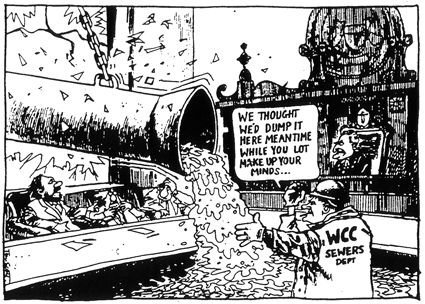
by Sharon Beder
first published by Allen & Unwin, Sydney, 1989
Introduction
Sewers seaward
Toothless watchdog
Toxic fish
Sewer-side surfing
Public relations battle
Events of 1989
Beyond Sydney
Conclusion
Bibliography
The Wellington controversy seems to have been a win for the people, although the final verdict has yet, to be announced. This has come about without change of engineers or engineering consultants, in a place not particularly renowned for its beaches, its beach culture or its aquatic sports.
Whi1st most of New Zealand’s main cities have secondary treatment, Wellington, the capital city, has been in turmoil over the past three years over what sewage treatment methods it should adopt. For 90 years, raw sewage has discharged at Moa Point, near the airport, causing shellfish in the area to become contaminated, gross pollution, and a danger to aircraft from the seagulls that are attracted to it. In the late 1970s, after some public pressure and national legislation to clean up waterways, Wellington City Council commissioned the engineering firm Beca Carter-Caldwell Connell (Caldwell Connell being the Sydney Water Board consultants) to do a study of treatment options for Wellington sewage.
Map – Location of proposed sewage treatment and disposal schemes
for Wellington and the Hutt Valley

In 1980 Beca Carter-Caldwell Connell recommended fine screening, high-rate primary treatment (involving putting the sewage into tanks for a while and skimming the oil and grease from the surface) and a long ocean outfall. (This is what is planned for North Head in Sydney except that there will not be fine screening) The opposition to this scheme, which was adopted by the council at the time, began to mount in 1984, heralded perhaps by Councillor Helene Ritchie dumping several bags of raw sewage that had been washed up at Moa Point onto a council works committee table (Evening Post, 12/4/86).
A few months later, the Wellington Clean Water Campaign was set up to lobby for land-based secondary treatment at a site away from Moa Point. It has been argued that this campaign was politically motivated and some key figures in it were from the Labour Party. But the Campaign was amazingly successful in gaining widespread popular support. It also became an issue for Maori people who claimed Moa Point had great cultural significance to their people. Thousands of people signed a petition asking for a poll on whether a loan of $10 million should be raised to pay for the fine screening (milliscreening) that was to be the first stage of sewage treatment at Moa Point. The milliscreen was characterised as a giant sieve and John Blincoe, convenor of the campaign, asked ‘Why put up with the sieve, dump and hope approach?’ (Dominion, 19/4/86).

Cartoon by Tom Scott for the Evening Post.
Under Wellington City Council rules, a petition with 15 per cent of ratepayers names can force such a poll and the Campaign claims it got 30 per cent. But disputes arose over the validity of people who had not put their full names (including middle names) and over women who had signed the petition but did not appear on the records of ratepayers because their husbands’ names came first on their home title deeds. Mayor Ian Lawrence told me later that many of the 12 000-odd signatures were women because women were not as conscious of costings and were less aware of the technical factors involved. They responded, he said, to the emotional issues, the women’s issues of health children, family and dirt.
Mayor Lawrence may have been reluctant to count the women’s vote but after a year of arguments and court battles, he finally agreed to have the poll. The poll seemed to show a majority vote against the loan, but this also led to disputes over invalid votes and accusations of manipulation.
The Council then proposed a temporary milliscreening plant at Moa Point. They argued that milliscreening would be a first stage no matter what treatment would later be put in, but the Clean Water Campaign argued that milliscreening at Moa Point could only lead to an ocean outfall at Moa Point. In October 1986, shortly after the loan poll, in council elections dominated by the sewage issue, the Mayor and many of his Citizen Party colleagues lost their seats. Labour Party candidates who adopted the policies of the Wellington Clean Water Campaign and who campaigned on the sewage issue won dominance of the Council. Blincoe was one of those elected.
Following the election the Wellington City Council began negotiations with the Hutt Valley Drainage Board (HVDB), which was responsible for the sewerage of a nearby region that also bordered Wellington Harbour. Wellington City Council wanted to build a joint secondary treatment plant for the HVDB on the Hutt Valley side of the Harbour. The HVDB were looking at their options for improved treatment anyway, because of the likely classification of the Harbour waters, but they already had milliscreening and preferred the idea of an extended ocean outfall to go with it rather than secondary treatment.
The HVDB had followed the controversy in Wellington and decided that they would do things differently. They decided to ‘educate’ the public and then give them the choice between ‘land-based’ treatment (secondary treatment) and ‘marine’ treatment (putting the sewage into the sea and letting it decompose there). They hired a public relations expert. The engineers at the HVDB had been particularly impressed by propaganda material being produced by the Sydney Water Board. When I visited them at the beginning of 1988 they delightedly pointed out the Water Board statement about anchovies off California producing as much faecal matter as 90 million people. ‘There’s some good stuff here that we can use,’ they told me.
During both public debates the engineering profession came out clearly in favour of the milliscreening and ‘marine treatment’ option. Blincoe told me that although many people donated their skills to the Clean Water Campaign, they were very short on engineers, which he viewed as being a very closed profession. The Institution of Professional Engineers (IPENZ) publicly supported the milliscreening option with statements familiar to Sydneysiders – ‘ocean outfalls can now be designed to use the sea’s own currents, its salt and its oxygen content to break down partially treated sewage so that high water quality could be obtained close to shore’ (Evening Post, 17/4/86).
Health Department officials in many cities often support engineers who propose minimal sewage treatment, and Wellington was no exception. The Deputy Director of the Hea1th Department said the idea tbat it was better to treat sewage before discharge into the sea was a myth (Wellington Our City, April 1986). He opposed the classification of the Harbour waters to make them safe for consumption of shell fish taken from them because it did not make allowance for the ‘business of getting rid of waste waters’. He argued that skindivers and people who collected shellfish were ‘a very tiny proportion of the population’, saying he did not know of anyone who had died or even been sick as a result of swimming or taking mussels where raw sewage was discharged at Moa Point. This, he said, was because sensible people had stayed away (Dominion, 17/4/86).
The Wellington City Engineer came out with the extraordinary statement that ‘it should be stressed that the effluent from a secondary treatment system is of no higher quality than the effluent from a primary system’ and the engineers from the HVDB asked a 1985 engineering conference, ‘Why waste valuable resources on treating sewage in a land based plant and deprive the fish of a useful food source?’ (Smith & Speir, 1985, p. 30).
The HVDB was less accountable to voters than the Wellington City Council because its members were not directly elected but appointed by local councils, and therefore only partly influenced by local opinion (more so than Sydney’s Water Board, which is almost totally appointed by the State Government). Although it tried to frame the debate to its way of thinking, the HVDB did canvass public opinion and put out a booklet entitled Your environment – your decision, which explained the technical options, discussed spiritual and cultural considerations, gave costings and actually left people with a real choice between two different options. Their reasoning for this approach had been that ‘people are happier to go along with things if they’ve got information and have had a chance to say their piece’ (personal communication, Feb. 1988).
When I spoke to them the HVDB engineers were ready to convince the Wellington City Council to join with them in building an extended ocean outfall as a first stage of a joint venture and then they would wait and see if more treatment was really necessary. They argued that the performance of the outfall could be monitored for a couple of years, which would allow some breathing space, and eventually the heat would die down and some of the emotion would go out of the debate, (something the Sydney Water Board has also been hoping for). They were confident the extended outfall would gain public support because of their public education programme, but they agreed that they would have to rethink if that did not happen.
The public opinion survey commissioned by the HVDB came out strongly in favour of secondary treatment rather than an extended ocean outfall. Secondary treatment was preferred because it would cause less pollution and because the treated sludge could be used as fertiliser. Sixty-nine per cent of people referred land-based treatment and this only dropped to 66 per cent when respondents were told it would mean their rates would increase by 25 per cent. Only 22 per cent of people polled preferred the extended outfall option.
After the Harbour waters were finally classified to be suitable for shell fishing the HVDB was persuaded by public opinion into actually signing up for a Joint Venture Agreement with Wellington City Council to build a secondary treatment plant.
Wellington City Council had also been confident that engineers could be brought into line with public opinion. Following the election, the Labour-dominated Wellington City Council decided to retain the same engineering consultants, Beca Carter, after calling for tenders from others. The council felt that the Moa Point recommendation had been made earlier when the engineers had assumed a narrower set of values, but if they took account of people’s values rather than assuming them, and took instruction from Council, there was no reason why they could not come up with more appropriate recommendations in future. The Council also employed oceanographer Ian Wallis (from Caldwell Connell) as overseer. Previous councils had also used him. He was known to be very good at presenting information to the public.
The latest episode in the Wellington saga has been that a temporary milliscreen had been installed at Moa Point. After signing the joint venture for land treatment with the HVDB, Wellington City Council were contacted by engineering consultants who argued that they could give Wellington a better treatment system for less cost than a joint secondary treatment system with the HVDB. The opposition, which had lost power because of its intransigence over secondary treatment, began pushing for these schemes, referred to in the newspapers as ‘high-tech systems’ of treatment.
The Council now believes it can install a treatment plant at a site near the airport that will produce an effluent that is tertiary standard and discharge it at or near Moa Point! They have called for engineering firms to put forward such schemes for evaluation but these firms have been told not to divulge details of their schemes publicly. Some of the schemes being proposed consist of advanced forms of primary treatment in conjunction with ultraviolet disinfection, which are attractive because they don’t take up much space. However, although advanced primary treatment can provide better ways to remove solid material it does not treat urine or dissolved material and is not secondary treatment. And disinfection has not traditionally been considered to be a stage of treatment.
As council elections draw close once more the issue is hotting up and it looks as if it will again dominate the campaigning. Already accusations have been flying about the Labour councillors being in collusion with one particular consultancy firm. The public have been told that they will be the ones to finally decide what scheme they want. One can only hope that they will be fully informed and do not get advanced primary treatment when they thought they were getting tertiary treatment.